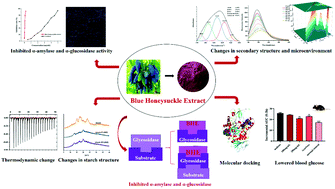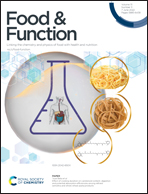Blue honeysuckle extracts retarded starch digestion by inhibiting glycosidases and changing the starch structure†
Abstract
Blue honeysuckle rich in anthocyanins can inhibit starch-digesting enzyme activity. This study evaluated the inhibitory effect and mechanism of blue honeysuckle extract (BHE) on glycosidases (α-amylase and α-glucosidase). BHE was a mixed glycosidase inhibitor with an IC50 of 2.36 ± 0.14 and 0.06 ± 0.01 for α-amylase and α-glucosidase, respectively. Fourier transform infrared (FTIR) spectroscopy, multi-fluorescence spectroscopy, and isothermal titration calorimetry (ITC) confirmed that BHE caused the secondary structure change and static fluorescence quenching of glycosidases, and the interaction was an enthalpy-driven exothermic reaction. Molecular docking proved that the main anthocyanin monomers in BHE interacted with glycosidases through hydrogen bonds and van der Waals forces. Moreover, BHE changed the starch structure and prevented starch from being digested by glycosidases. In vivo, BHE and starch-BHE complexes effectively slowed postprandial hyperglycemia. This research provided a theoretical basis for BHE in antidiabetic healthy food research and development.



 Please wait while we load your content...
Please wait while we load your content...